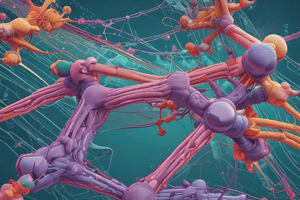Podcast
Questions and Answers
What are the functions of molecular chaperones?
What are the functions of molecular chaperones?
Bind exposed hydrophobic domains and prevent them from aggregating; assist in folding.
What are the 2 major classes of molecular chaperones?
What are the 2 major classes of molecular chaperones?
Hsp70-type and chaperonin (TriC in eukaryotes and GroEL/GroES in bacteria).
What type of protein does not require chaperones at all?
What type of protein does not require chaperones at all?
Small proteins with no large hydrophobic regions.
Describe the structure of GroEL/GroES chaperonin in E.coli.
Describe the structure of GroEL/GroES chaperonin in E.coli.
Describe the folding cycle of GroEL/GroES chaperonin.
Describe the folding cycle of GroEL/GroES chaperonin.
How do chaperones speed up the kinetics of folding? What are the two theories for how this occurs?
How do chaperones speed up the kinetics of folding? What are the two theories for how this occurs?
Steroid receptors require what chaperone to put them in a conformation capable of binding hormones?
Steroid receptors require what chaperone to put them in a conformation capable of binding hormones?
Hsp90 client proteins are involved in many phenotypes displayed by cancer cells.
Hsp90 client proteins are involved in many phenotypes displayed by cancer cells.
What inhibits hsp90?
What inhibits hsp90?
Flashcards are hidden until you start studying
Study Notes
Functions of Molecular Chaperones
- Bind to exposed hydrophobic regions of proteins, preventing aggregation.
- Facilitate correct protein folding.
Major Classes of Molecular Chaperones
- Hsp70-type chaperones.
- Chaperonin chaperones: TriC in eukaryotes; GroEL/GroES in bacteria.
Proteins That Don't Require Chaperones
- Small proteins lacking large hydrophobic domains do not need chaperone assistance.
Structure of GroEL/GroES in E. coli
- Comprises two identical rings with seven GroEL subunits each.
- Contains a cap made of seven GroES subunits.
- Features a hydrophobic patch inside the GroEL barrel, crucial for recruiting unfolded proteins.
Folding Cycle of GroEL/GroES Chaperonin
- An unfolded protein attaches to a GroEL ring, binding 7 ATP, allowing GroEL to connect with GroES cap.
- The attachment of GroES induces a conformational change in GroEL to the cis state.
- ATP molecules are hydrolyzed to ADP in the GroEL ring.
- A second unfolded protein binds to the other GroEL ring (in trans state) with 7 ATP, leading to the release of the GroES cap and a better-folded protein from the first ring.
- The trans ring subsequently changes to the cis state.
Kinetics of Protein Folding by Chaperones
- Chaperones enhance folding kinetics by reducing kinetically trapped intermediates.
- Theoretical mechanisms:
- Iterative annealing: Chaperones unfold intermediate states to promote further folding.
- Confinement: The controlled environment within chaperonins "smooths" the energy landscape for more efficient folding.
Steroid Receptors and Chaperones
- hsp90 is required for steroid receptors to achieve a conformation that binds hormones effectively.
Hsp90 and Cancer Phenotypes
- Hsp90 client proteins play significant roles in various cancer cell phenotypes.
Inhibitors of Hsp90
- Geldanamycin and its derivatives (17-AAG, 17-DMAG) are known inhibitors of hsp90 activity.
Studying That Suits You
Use AI to generate personalized quizzes and flashcards to suit your learning preferences.




